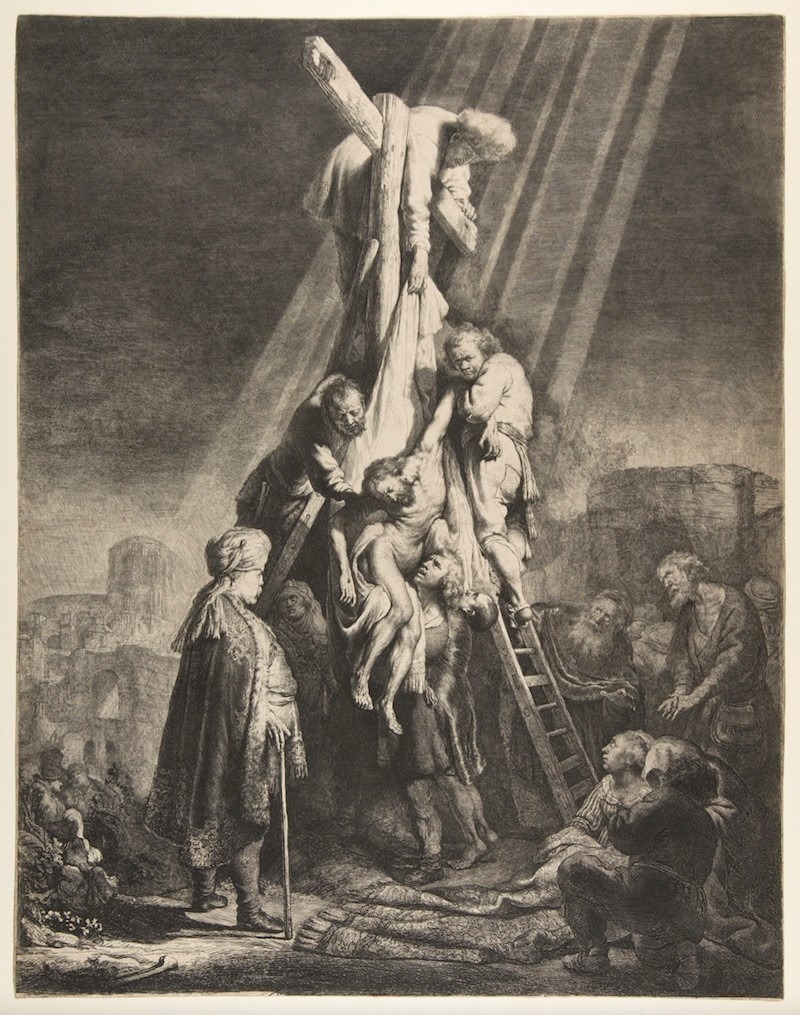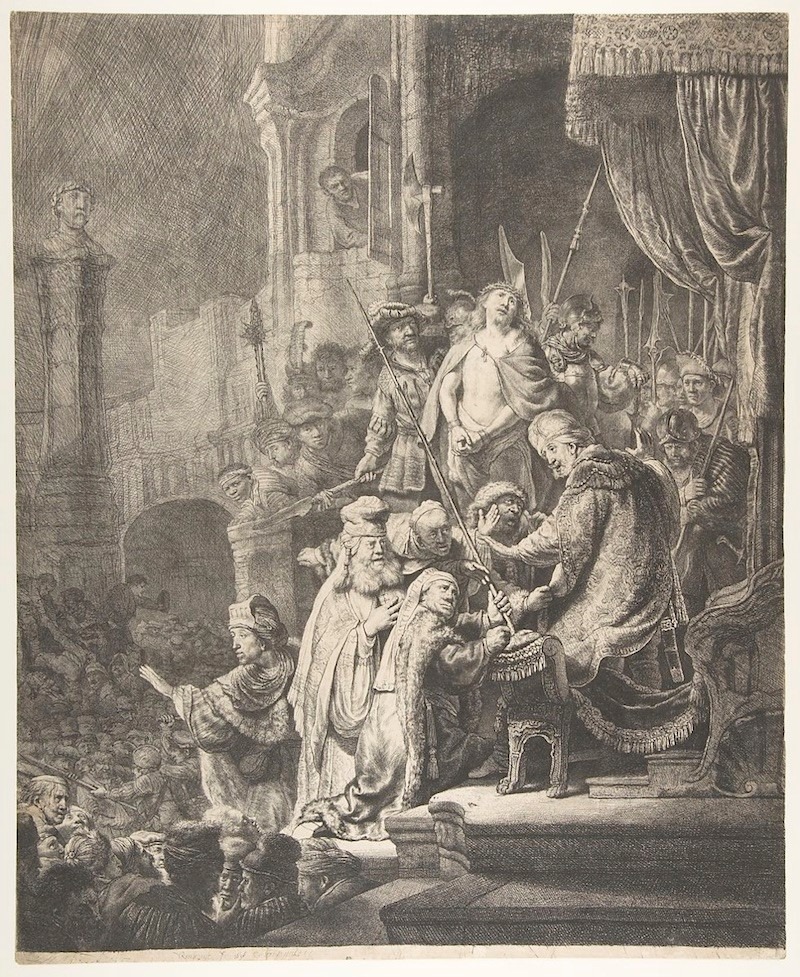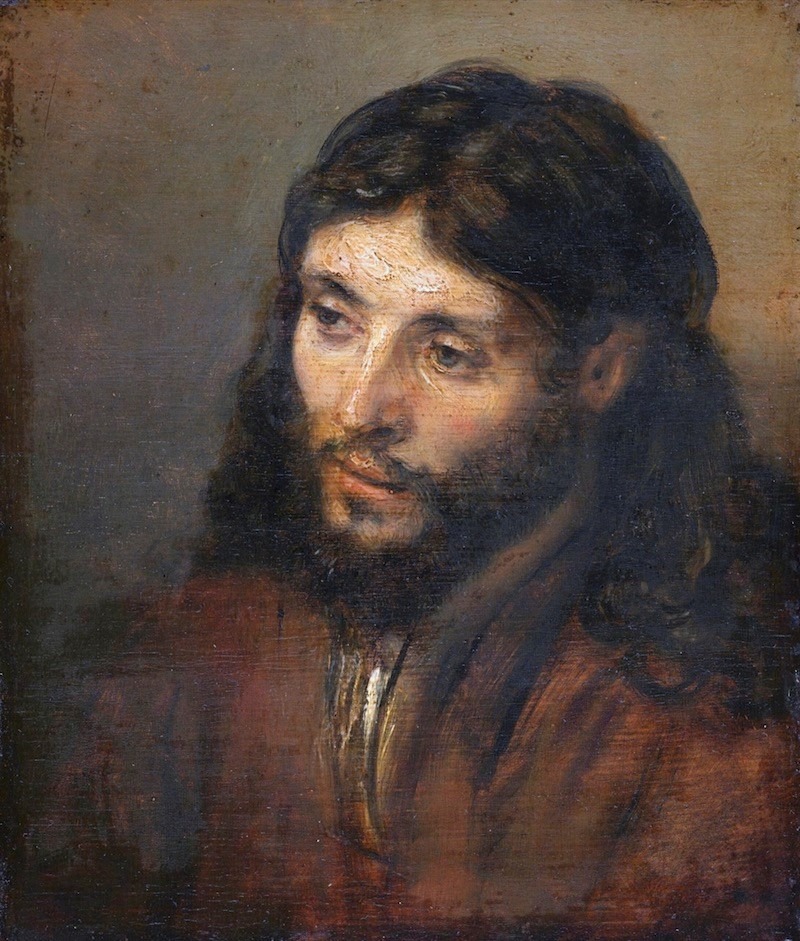Rembrandus Hermanni Leidensis, as the artist signed his works, started to etch in 1626 at the age of 20. His first dated painting (“The Stoning of St. Stephen”) was in 1625.
Rembrandt was prolific as an etcher, with over 300 plates during his lifetime. Many were of biblical subjects. Those that depicted Jesus Christ were usually etched with the traditional image. We will see it below. Christ was shown with a full beard and an almost gaunt visage. There was only one exception to the choice of visage. We will show you that one as well.
In 1633, Rembrandt started his only two large plates. They are the only two for which he claimed the copyright privilege “cum privile.” It is believed that these two large plates were intended for widespread publication (many printings).
In 1632–33, Rembrandt was “a smash success as a painter in Amsterdam and the Hague” (source: The complete etchings of Rembrandt, the Dover edition published in 1994, unabridged, and a corrected version of the 1977 original, edited by Gary Schwartz, Maarssen). By 1633 Rembrandt was nearing his career peak as a portrait painter, and his etchings were prized due to the artist’s great finesse.
“The Descent from the Cross: the second plate” was finished in 1633 and depicts a bearded, traditional portrait of Jesus.

(https://www.metmuseum.org/art/collection/search/371058)
Rembrandt married Saskia van Uylenburgh in 1634; their first child, a boy, Rumbartus, was born in 1635 but died within two months. Following the death of his son, Rembrandt’s etching and painting production started to decline.
Rembrandt’s second large plate, which he had started in 1633, was finished in 1636. It completes the pair of extraordinary etchings and is titled “Christ Before Pilate.”

(https://www.metmuseum.org/art/collection/search/373921)
In addition to the size and “cum privile” copyright status of the two large plates, there is one other remarkable element.
Notice what Rembrandt did with the visage of Christ. He made it into a self-portrait.
In both large plates we see the figure of Pilate. And we see other faces. But the traditional visage of a bearded Jesus was replaced by Rembrandt’s own lightly bearded face in the 1636 etching. We can speculate as to why. Did Rembrandt see himself as having sacrificed his son? Did his grief lead him to identify with the suffering of Christ or perhaps to perceive God’s presence in his own suffering? What was his thinking? We can only speculate. In his original oil sketch, with which he started both large plates in 1633, did he contemplate a different face?
In the 1640s, Rembrandt’s Christ would no longer wear the face of the artist.

(https://en.wikipedia.org/wiki/Head_of_Christ_(Rembrandt)#/media/File:Rembrandt_Harmensz._van_Rijn_048.jpg)
There are many things to contemplate this year during this Easter and Passover period of holy respect. And the questions are profound. Last year we contemplated the meaning of the pairing of Rembrandt’s two etchings. That was in the early days of the pandemic. Here’s the link to that message: https://www.cumber.com/cumberland-advisors-commentary-the-biblical-rembrandt/. Somehow COVID and a year of loss has subtly altered the view. The same masterpieces by the same artist offer a different perspective today, as perceptions of any work of art bridge the worlds of the artist and the viewer.
May your holiday time be peaceful.
David R. Kotok
Chairman of the Board & Chief Investment Officer
Email | Bio
Links to other websites or electronic media controlled or offered by Third-Parties (non-affiliates of Cumberland Advisors) are provided only as a reference and courtesy to our users. Cumberland Advisors has no control over such websites, does not recommend or endorse any opinions, ideas, products, information, or content of such sites, and makes no warranties as to the accuracy, completeness, reliability or suitability of their content. Cumberland Advisors hereby disclaims liability for any information, materials, products or services posted or offered at any of the Third-Party websites. The Third-Party may have a privacy and/or security policy different from that of Cumberland Advisors. Therefore, please refer to the specific privacy and security policies of the Third-Party when accessing their websites. Sign up for our FREE Cumberland Market Commentaries Cumberland Advisors Market Commentaries offer insights and analysis on upcoming, important economic issues that potentially impact global financial markets. Our team shares their thinking on global economic developments, market news and other factors that often influence investment opportunities and strategies.

